(I’m in Vegas, waiting for HP Discover to start(got here Friday afternoon), this time around I had my own company pay my way, so HP isn’t providing me with the trip. Since I haven’t been blogging much the past year I didn’t feel good about asking HP to cover me as a blogger.)
UPDATED – 6/4/2015
When flash first started becoming a force to be reckoned with a few years ago in enterprise storage it was clear to me controller performance wasn’t up to the task of being able to exploit the performance potential of the medium. The ratio of controllers to SSDs was just way out of whack.
In my opinion this has been largely addressed in the 3PAR Generation 5 systems that are being released today.
NEW HP 3PAR 20800
I believe this replaces the 10800/V800 (2-8 controllers) system, I believe it also replaces the 10400/V400(2-4 controllers) system as well.
- 2-8 controllers, max 96 x 2.5Ghz CPU cores(12/controller) and 16 Generation 5 ASICs (2/controller)
- 224GB of RAM cache per controller (1.8TB total – 768GB control / 1,024GB data)
- Up to 32TB of Flash read cache
- Up to 6PB of raw capacity (SSD+HDD)
- Up to 15PB of usable capacity w/deduplication
- 12Gb SAS back end, 16Gb FC (Max 160 ports) / 10Gb iSCSI (Max 80 ports) front end
- 10 Gigabit ethernet replication port per controller
- 2.5 Million Read IOPS under 1 millisecond
- Up to 75 Gigabytes/second throughput (read), up to 30 Gigabytes/second throughput (write)
NEW HP 3PAR 20850
This augments the existing 7450 with a high end 8-controller capable all flash offering, similar to the 20800 but with more adrenaline.
- 2-8 controllers, max 128 x 2.5Ghz CPU cores(16/controller), and 16 Generation 5 ASICs (2/controller)
- 448GB of RAM cache per controller (3.6TB total – 1,536GB control – 2,048GB data)
- Up to 4PB of raw capacity (SSD only)
- Up to 10PB of usable capacity w/deduplication
- 12Gb SAS back end, 16Gb FC (Max 160 ports) / 10Gb iSCSI (Max 80 ports) front end
- 10 Gigabit ethernet replication port per controller
- 3.2 Million Read IOPS under 1 millisecond
- 75 Gigabytes/second throughput (read), 30 Gigabytes/second throughput (write)
Even though flash is really, really fast, 3PAR leverages large amounts of cache to optimize writes to the back end media, this not only improves performance but extends SSD life. If I recall correctly nearly 100% of the cache on the all SSD-systems is write cache, reads are really cheap so very little caching is done on reads.
It’s only going to get faster
One of the bits of info I learned is that the claimed throughput by HP is a software limitation at this point. The hardware is capable of much more and performance will improve as the software matures to leverage the new capabilities of the Generation 5 ASIC (code named “Harrier 2”).
Magazine sleds are no more
Since the launch of the early 3PAR high end units more than a decade ago 3PAR had leveraged custom drive magazines which allowed them to scale to 40×3.5″ drives in a 4U enclosure. That is quite dense, though they did not have similar ultra density for 2.5″ drives. I was told that nearline drives represent around 10% of disks sold on 3PAR so they decided to do away with these high density enclosures and go with 2U enclosures without drive magazines. This allows them to scale to 48×2.5″ drives in 4U (vs 40 2.5″ in 4U before), but only 24×3.5″ drives in 4U (vs 40 before). Since probably greater than 80% of the drives they ship now are 2.5″ that is probably not a big deal. But as a 3PAR historian(perhaps) I found it interesting.
Along similar lines, the new 20k series systems are fully compatible with 3rd party racks. The previous 10k series as far as I know the 4-node variant was 3rd party compatible but 8-node required a custom HP rack.
Inner guts of a 3PAR 20k-series controller
With dual internal SATA SSDs for the operating system(I assume some sort of mirroring going on), eight memory slots for data cache(max 32GB per slot) – these are directly connected to the pair of ASICs(under the black heatsinks). Another six memory slots for the control cache(operating system, meta data etc) also max 32GB per slot those are controlled by the Intel processors under the giant heat sinks.
How much does it cost?
I’m told the new 20k series is surprisingly cost effective in the market. The price point is significantly lower than earlier generation high end 3PAR systems. It’s priced higher than the all flash 7450 for example but not significantly more, entry level pricing is said to be in the $100,000 range, and I heard a number tossed around that was lower than that. I would assume that the blanket thin provisioning licensing model of the 7000 series extends to the new 20k series, but I am not certain.
It is only available in a 8-controller capable system at this time, so requires at least 16U of space for the controllers since they are connected over the same sort of backplane as earlier models. Maybe in the future HP will release a smaller 2-4 controller capable system or they may leave that to whatever replaces the 7450. I hope they come out with a smaller model because the port scalability of the 7000-series(and F and E classes before them) is my #1 complaint on that platform, having only one PCIe expansion slot/controller is not sufficient.
NEW HP 3PAR 3.84TB cMLC SSD
HP says that this is the new Sandisk Optimus MAX 4TB drive, which is targeted at read intensive applications. If a customer decides to use this drive in non read intensive(and non 3PAR) then the capacity will drop to 3.2TB. So with 3PAR’s adaptive sparing they are able to gain 600GB of capacity on the drive while simultaneously supporting any workload without sacrificing anything.
This is double the size of the 1.92TB drive that was released last year. It will be available on at least the 20k and the 7450, most likely all other Gen4 3PAR platforms as well.
HP says this drops the effective cost of flash to $1.50/GB usable.
This new SSD comes with the same 5 year unconditional warranty that other 3PAR SSDs already enjoy.
I specifically mention the 7450 here because this new SSD effectively doubles the raw capacity of the system to 920TB of raw flash today (vs 460TB before). How many all flash systems scale to nearly a petabyte of raw flash?
NEW HP 3PAR Persistent Checksum
With the Generation 4 systems 3PAR had end to end T10 data integrity checking within the array itself from the HBAs to the ASICs, to the back end ports and disks/SSDs. Today they are extending that to the host HBAs, and fibre channel switches as well (not sure if this extends to iSCSI connections or not).
The Generation 5 ASIC has a new line rate SHA1 engine which replaces the line rate CRC engine in Generation 4 for even better data protection. I am not certain if persistent checksum is Generation 5 specific(given they are extending it beyond the array I really would expect it to be possible in Generation 4 as well).
NEW HP 3PAR Asynchronous Streaming Replication
I first heard about this almost two years ago at HP Storage Tech Day, but today it’s finally here. HP adds another method of replication to the existing sets they already had:
- Synchronous replication – 0 data loss (strict latency limits)
- Synchronous long distance replication (requires 3 arrays) – 0 data loss (latency limits between two of the three arrays)
- Asynchronous replication – as low as 5 minutes of data loss (less strict latency limits)
- Asynchronous streaming replication – as low as 1 second of data loss (less strict latency limits)
HP compares this to EMC’s SRDF async replication which has as low as a 15 seconds of data loss, vs 3PAR with as low as 1 second.
If for some reason more data comes into the system than the replication link can handle, the 3PAR will automatically go into asynchronous replication mode until the replication is caught up then switch back to asynchronous streaming.
This new feature is available on all Gen4 and Gen5 systems.
NEW Co-ordinated Snapshots
3PAR has long had the ability to snapshot multiple volumes on a single system simultaneously, and it’s always been really easy to use. Now they have extended this to be able to snapshot across multiple arrays simultaneously and make them application aware (in the case of VMware initially, Exchange, SQL Server and Oracle to follow).
This new feature is available on all Gen4 and Gen5 systems.
HP 3PAR Storage Federation
Up to 60PB of usable capacity and 10 Million IOPS with zero overhead
HP has talked about Storage Federation in the past, today with the new systems of course the capacity knobs have been turned up a lot, they’ve made it easier to use than earlier versions of the software, though don’t yet have completely automatic load balancing between arrays yet.
This federation is possible between all Gen4 and Gen5 systems.
Benefits from ASIC Acceleration
3PAR has always use in house custom ASICs on their systems and these are no different
The ASICs within each HP 3PAR StoreServ 20850 and 20800 Storage controller node serve as the high-performance engines that move data between three I/O buses, a four memory-bank data cache, and seven high-speed links to the other controller nodes over the full-mesh backplane. These ASICs perform RAID parity calculations on the data cache and inline zero-detection to support the system’s data compaction technologies. CRC Logical Block Guard used by T10-DIF is automatically calculated by the HBAs to validate data stored on drives with no additional CPU overhead. An HP 3PAR StoreServ 20800 Storage system with eight controller nodes has 16 ASICs totaling 224 GB/s of peak interconnect bandwidth.
NEW Online data import from HDS arrays
You are now able to do online import of data volumes from Hitachi arrays in addition to the EMC VMAX, CX4, VNX, and HP EVA systems.
The competition
HP touts the scalability of usable and raw flash capacity of these new systems + the new 3.84TB SSD against their competition:
- Consolidate thirty Pure Storage //m70 storage systems onto a single 3PAR 20850 (with 87% less power/cooling/space) ***
- Consolidate eight XtremeIO storage systems onto a single 3PAR 20850 (with 62% less power/cooling/space)
- Consolidate three EMC VMAX 400K storage systems onto a single 3PAR 20850 (with 85% less power/cooling/space)
HP also touts their throughput numbers (75GB/second) are between two and ten times faster than the competition. The 7450 came in at only 5.5GB/second, so this is quite a step up.
*** HP revised their presentation last minute their original claims were against the Pure 450, which was replaced by the m70 on the same day of the 3PAR announcement. The numbers here are from memory from a couple of days ago they may not be completely accurate.
Fastest growing in the market
HP touted again 3PAR was the fastest growing all flash in the market last year. They also said they have sold more than 1,000 all flash systems in the first half which is more than Pure Storage sold in all of last year. In other talks with 3PAR folks specifically on market share they say they are #1 in midrange in Europe and #2 in Americas, with solid growth across the board consistently for many quarters now. 3PAR is still #5 in the all flash market, part of that is likely due to compression(see below), but I have no doubt this new generation of systems will have a big impact on the market.
Still to come
Compression remains a road map item, they are working on it, but obviously not ready for release today. Also this marks probably the first 3PAR hardware released in more than a decade that wasn’t accompanied by SPC-1 results. HP says SPC-1 is coming, and it’s likely they will do their first SPC-2 (throughput) test on the new systems as well.
Bottom line
HP continues to show that it’s 3PAR architecture is fully capable of embracing the all flash era and has a long life left in it. Not only are you getting the maturity of the enterprise proven 3PAR systems (over a decade at this point), but you are not having to compromise on almost anything else related to all flash(compression being the last holdout).
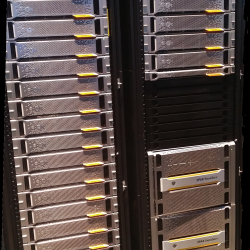
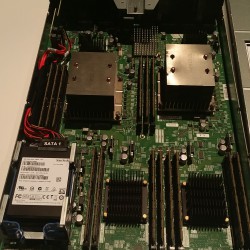
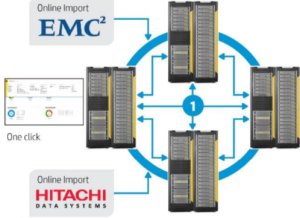
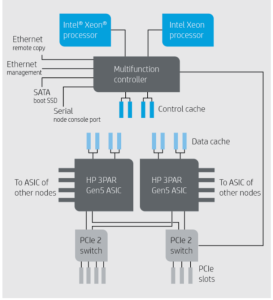
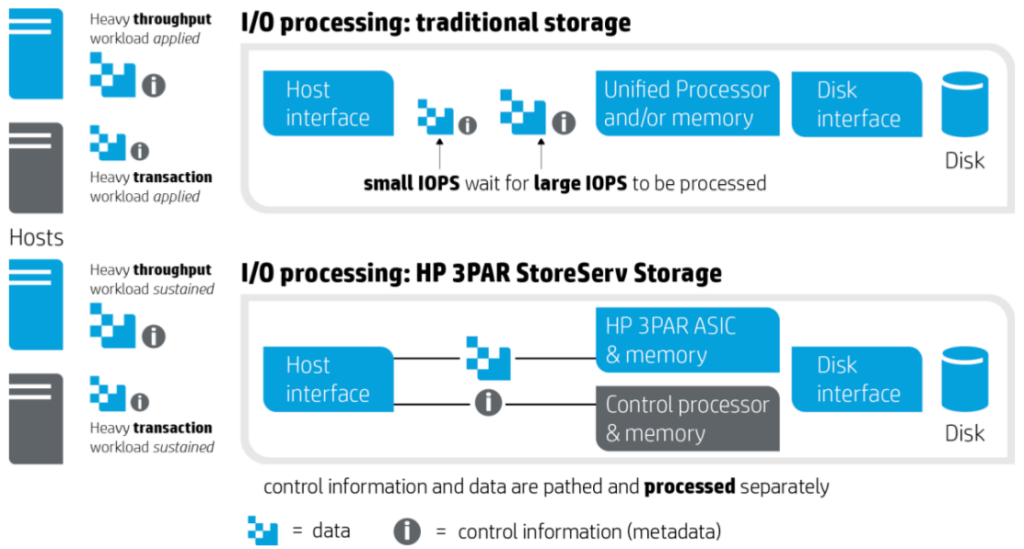
I still don’t understand why someone would choose something over 3par in this day and age.
Comment by Eddie — June 1, 2015 @ 11:43 am
Hey Eddie! Me too for the most part anyway, there are still gaps in some of the software(I use very very little host-based 3PAR software). It’s a question I plan to ask HP at Discover here what do they see as the barrier(s) to further market share growth.
I noticed Pure Storage announced some new models today as well perhaps they would of been wise to pick another day, since these new 3PAR boxes scale 10x higher than the new Pure stuff.
Comment by Nate — June 1, 2015 @ 11:52 am
Eddie, we chose Dell Compellent for our DR site because HP 3Par Adaptive Optimization is way too slow to react to data getting hot. With our DR site most data will be cold until we roll over and so it’s a serious consideration. We would consider going all flash to eliminate the issue but even HP’s touted $1.50/GB is still ~10x more expensive than an NL tier which would end up costing us ~$150k more to host on flash even if we could achieve the 4:1 data reduction that HP’s number requires. We like our 3Par, and it’s been highly reliable and I wish the Dell had cage availability but the weaknesses of AO and the refusal of 3Par to add an option for flash based write caching pushed us to another solution. Also the new Dell SCv2080 kicks the 7200 all over the place, 168 drives in 10U and no per-drive licensing.
Comment by Andrew Fidel — June 9, 2015 @ 7:19 am
[…] Nate Amsden – 3PAR Gen5 true flash scale storage […]
Pingback by HP Discover Videos and Blogs | 3ParDude — June 16, 2015 @ 12:33 am
Great article, wish I was lucky enough to attend these events! Also glad to see a new post as I’ve enjoyed reading your others.
I think I’ll struggle to convince my manager to buy me a 20850 but I can dream. With regard to Andrews comment I also agree that AO needs to be enhanced to allow remote copy volumes to receive AO data so it can be tiered appropriately. We have 2 x 7400 arrays in separate DCs synchronously replicating and I have concerns around how well things will go in a full failover IO wise, at least till AO kicks in and does it’s job.
Comment by Alex Bytes — July 1, 2015 @ 4:09 am